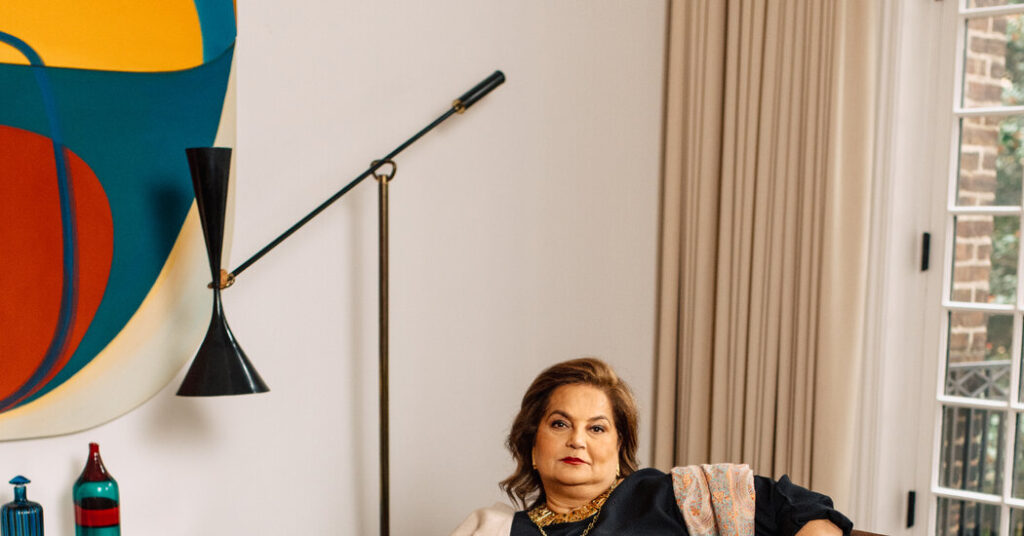Mahnaz Ispahani Bartos’s 1985 doctoral thesis on Russian, Chinese and American road building across South and Central Asia in the 20th century does not sound like the obvious precursor to a career in jewelry.
“At dinner parties, people would ask me what I was up to and then when I told them, turn away to the guest on the other side,” she recalled with a smile.
It does, however, indicate Ms. Isphani Bartos, a Manhattan jewelry dealer, has a passion for obscure but deserving topics of study, something that has helped her bring jewelry masters of the past to new generations of collectors.
After receiving her doctorate from Tufts University, Ms. Ispahani Bartos embarked on an international relations career that included a decade at the Ford Foundation. But exhausted by war and weapons, she switched careers in 2013, indulging her lifelong love of jewelry to start the Mahnaz Collection, an appointment-only salon on Madison Avenue.
Ms. Ispahani Bartos quickly built a reputation for astute assessments of independent jewelry artists and makers from the mid-20th century to the present day. They include Andrew Grima, from England; Giorgio Facchini, from Italy; Roberto Burle Marx, from Brazil, and the Indigenous artists Charles Loloma and Verma Nequatewa (known as Sonwai), from the United States.
“Mahnaz put the British jewelers of the ‘60s and ‘70s on the map in America,” said Joanna Hardy, a jewelry specialist in Britain. And, she added, Ms. Ispahani Bartos put American Indigenous jewelers “on the map globally.” (Ms. Hardy contributed a chapter to “London Originals,” the catalog for Ms. Ispahani Bartos’s 2018 exhibition on post-World War II jewelry makers in Britain, staged at the Wright auction house in New York City.)
Frank Everett, a senior vice president and vice chairman of jewelry in the Americas at Sotheby’s New York, agreed: “Few people in this industry have as much passion, focus and knowledge as Mahnaz. She is as much an historian and educator as she is a dealer. The designers and artists she champions are of a very specific time and aesthetic, some of whom might have been forgotten were it not for her.”
In December, Ms. Ispahani Bartos is giving clients a window into her collecting world with a selling exhibition at her salon called “Metamorphosis — Jewelry Design from Paris to the U.S. Pueblos, 1950s — 1990s.”
The display, which will be open from Dec. 2 – 23, includes more than 150 jewels from $750 to $150,000.
“The postwar period was such an exciting time for design,” said Ms. Ispahani Bartos, 66. “There were so many changes in society with the peace movement and emergence of the working woman. Then there was Brutalist architecture, Pop Art and Op Art and all these wild and crazy jewelers like Grima in London, who turned the world of jewelry design on its head.
“It wasn’t Cartier’s India that influenced the world this time, it was the Beatles’ India.”
The exhibition is organized in part geographically, according to the various locations that Ms. Ispahani Bartos has researched.
For example, it includes creations by several of the female jewelers who worked at the Danish house Georg Jensen during the post-World War II period, including an amethyst cabochon ring by Tuk Fischer.
“She was just one in an extraordinary line of women jewelers that Jensen brought in, beginning with Vivianna Torun,” Ms. Ispahani Bartos said. “Their modern minimalist jewels show you the difference between fashion and style. So some things are stylish and therefore keep coming back, keep returning. And some things are fashionable, but I feel less enduring.”
The display also includes a pair of long, sculptural gold earrings, made by the English jeweler Wendy Ramshaw in 1998. When not being worn, they are intended to be displayed on one of Ramshaw’s signature fitted brass stands.
“I didn’t do it consciously,” Ms. Ispahani Bartos said, “but looking back, some of the most dynamic pieces I have collected are by women designers.”
Works by Indigenous American jewelers are another of her passions, such as a silver ring by Mr. Loloma incorporating ebony, coral, lapis lazuli and turquoise in the selection on view.
In 2007 Ms. Ispahani Bartos started spending time in Santa Fe, N.M., and still owns a home there, and she said that she has maintained the close relationships she developed with its jewelers and dealers. (Her salon’s 2018 exhibition and catalog, titled “Material Beauty,” focused on modern Hopi, Navajo and Pueblo artist jewelers such as Mr. Loloma and Richard Chavez.)
Historically, she said, there had been few female jewelers from those communities. “It was a trade men handed down to their sons because it emerged from a silversmithing tradition that focused on horse bridles and so on,” she said.
Ms. Nequatewa, one of Mr. Loloma’s nieces, has helped to change that, Ms. Ispahani Bartos said. She apprenticed with her uncle for almost 20 years and now continues his legacy of stone inlay work with her own twist. A silver ring she created featuring Royston turquoise, from the Royston mine in Nevada, is part of the exhibition selection.
One thing that drew her to Indigenous jewelry, Ms. Ispahani Bartos said, was the prevalence of turquoise. She has had a lifelong love of the stone, thanks to her paternal grandmother who gave her turquoise earrings as a child and told her stories about the gem’s protective properties.
Ms. Ispahani Bartos was born in Karachi, Pakistan, the eldest of three daughters in a wealthy family. Her paternal grandfather, Mirza Abol Hassan Ispahani, was the first ambassador of Pakistan to the United States, serving from 1947-52.
She credits her father, Mirza Mohamed Iskander Ispahani, a businessman and philanthropist, for allowing her to be educated in Switzerland and, later, at Wellesley College in Massachusetts (she said that he insisted on an all-female college).
“I have such gratitude to this country,” she said. “It allowed me to define myself as a woman. In Pakistan, my role was already defined.”
And she credited her mother, Syeda Akhtar Zehra Ispahani, with her sense of style and independence. Ms. Ispahani Bartos said that her a mother, a collector of contemporary South Asian art, would pair Indian-style family heirloom emerald necklaces with “wild Mexican earrings she’d bought on a trip with my father.”
“She was also daring in her decision to wear Celine pantsuits in Pakistan at a time when that was frowned upon,” she added.
The period in which Ms. Ispahani Bartos grew up also influenced her love of architecture, particularly the Brutalist style. (Her career-long commitment to serving on the boards of several nonprofit organizations, including 20 years with the New York Public Library, involved her in the $200 million renovation of its Midtown campus and more recently, in the $335 million redesign of a portion of Lincoln Center.)
Architecture, in turn, has had an impact on her jewelry taste. The exhibition display includes a bold necklace and matching cuff that contrast Brutalist-style textured yellow gold with mirror-polish white gold. It is a 1970s piece from the French jewelry house Chaumet, which at the time was breaking away from its past to embrace the avant-garde under the artistic direction of René Morin and with the influence of the designer Pierre Sterlé.
“They illustrate how a heritage house evolved from creating tiaras to crafting totemic jewels that brilliantly expressed the spirit and artistry of their time,” Ms. Ispahani Bartos said. “I want talented designers like them to be remembered.”
The post A Jewelry Dealer Profits From Her Love of Research appeared first on New York Times.




